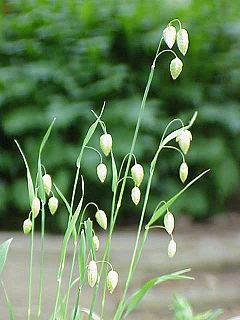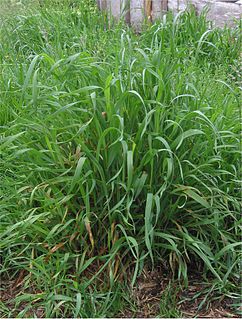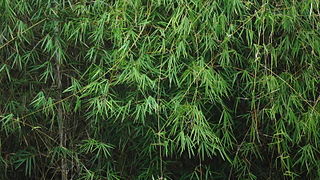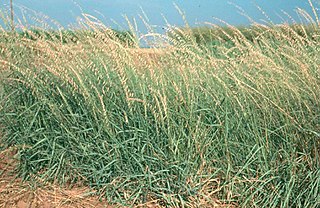
Poaceae or Gramineae is a large and nearly ubiquitous family of monocotyledonous flowering plants known as grasses. It includes the cereal grasses, bamboos and the grasses of natural grassland and species cultivated in lawns and pasture. The latter are commonly referred to collectively as grass.

Goobang is a national park located in New South Wales, Australia, 296 kilometres (184 mi) northwest of Sydney. It protects the largest remnant forest and woodland in the central west region of the state, where interior and coastal New South Wales flora and fauna species overlap. Originally named Herveys Range by John Oxley in 1817, the area was reserved in 1897 as state forest because of its importance as a timber resource, and was designated a national park in 1995.

The Nightcap National Park is a national park situated within the Nightcap Range in the Northern Rivers region of New South Wales, Australia. The 8,080-hectare (20,000-acre) park was created in April 1983 and is situated 35 kilometres (22 mi) north of Lismore. The national park is classed by the IUCN World Commission on Protected Areas as Category II and is part of the Shield Volcano Group of the World Heritage Site Gondwana Rainforests of Australia inscribed in 1986 and added to the Australian National Heritage List in 2007. The park was severely burned during the 2019-2020 Australian brushfire season, and its biodiversity has likely been decimated.

Briza is a genus of annual and perennial plants in the grass family, native to northern temperate regions of Eurasia, North Africa, and certain islands in the Atlantic.

Paspalum is a genus of plants in the grass family.

Elymus repens, commonly known as couch grass, is a very common perennial species of grass native to most of Europe, Asia, the Arctic biome, and northwest Africa. It has been brought into other mild northern climates for forage or erosion control, but is often considered a weed.

Panicum (panicgrass) is a large genus of about 450 species of grasses native throughout the tropical regions of the world, with a few species extending into the northern temperate zone. They are often large, annual or perennial grasses, growing to 1–3 m tall.

Atractantha is a South American genus of bamboo in the grass family, native to Brazil, Colombia, and Venezuela.
- Atractantha amazonicaJudz. & L.G.Clark - Amazonas in Brazil, Amazonas in Venezuela, Vaupés in Colombia
- Atractantha aureolanataJudz. - Espírito Santo, Bahia
- Atractantha cardinalisJudz. - Bahia
- Atractantha falcataMcClure - Bahia
- Atractantha radiataMcClure - Bahia
- Atractantha shepherdianaSantos-Gonç. - Espírito Santo

Aristida is a very nearly cosmopolitan genus of plants in the grass family. Aristida is distinguished by having three awns (bristles) on each lemma of each floret. The genus includes about 300 species found worldwide, often in arid warm regions. This genus is among those colloquially called three-awnswiregrasses, speargrasses and needlegrasses. The name Aristida is derived from the Latin "arista", meaning "awn".

Bouteloua is a genus of plants in the grass family. Members of the genus are commonly known as grama grass.

Astrebla is a small genus of xerophytic grasses found only in Australia. They are the dominant grass across much of the continent. They are commonly known as Mitchell grass after Scottish explorer, Thomas Mitchell, who first collected a specimen near Bourke in New South Wales.

Lepturus is a genus of plants in the grass family, native to Asia, Africa, Australia, and various islands in the Indian and Pacific Oceans.
Acostia is a genus of South American plants in the grass family.
Acrachne is a genus of Asian, African, and Australian plants in the grass family. Species in the genus are commonly known as goosegrass.
Ancistragrostis is a genus of Australian and New Guinean plants in the family Poaceae.
Arthragrostis is a genus of Australian plants in the grass family, found only in Queensland.

Brachyachne is a genus of African, Australian, and Southeast Asian plants in the grass family.
Austrofestuca, called beach fescue, is a genus of Australian and New Zealand plants in the grass family. The only accepted species is Austrofestuca littoralis, native to seacoast regions in Australia and New Zealand.
Rytidosperma pumilum, also known as feldmark grass, is a species of grass in the family Poaceae. It is found in Australia and New Zealand.

Elatostema is a genus of flowering plants containing approximately 350 known species in the nettle family Urticaceae, native to tropical forest clearings throughout Australasia, Asia and Africa. There may be as many as 1,000 species of this little-known genus, which is susceptible to deforestation and other forms of human exploitation. Some species, for instance the recently discovered E. fengshanense, show unusual adaptations to growing in deep shade in caves. DNA analysis suggests that the three genera Elastostema, Pellionia, and Pilea be grouped together as one.













